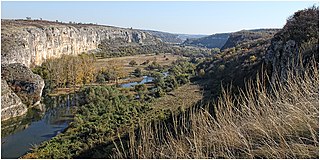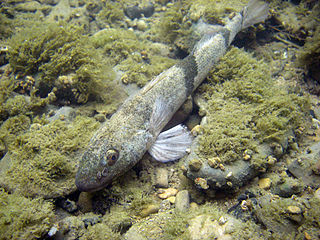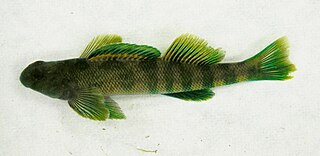
The Percidae are a family of ray-finned fish, part of the order Perciformes, which are found in fresh and brackish waters of the Northern Hemisphere. The majority are Nearctic, but there are also Palearctic species. The family contains more than 200 species in 11 genera. The perches and their relatives are in this family; well-known species include the walleye, sauger, ruffe, and three species of perch. However, small fish known as darters are also a part of this family.

The Vit is a river in northern Bulgaria, a right tributary of the Danube. Its length including the main stem Beli (White) Vit is 189 km, while the river proper, formed by the confluence of the Beli and Cherni (Black) Vit is 153 km. Vit Ice Piedmont in Antarctica is named after the river. The fish species Vit sculpin of the genus Cottus is endemic to the Vit.

The Iskar is a right tributary of the Danube. With a length of 368 km, it is the longest river that runs entirely within Bulgaria. Originating as three forks in Balkan's highest mountain range Rila, the Iskar flows in a northern direction until its confluence with the Danube. As it flows northwards it fuels the largest artificial lake in the country, the Iskar Reservoir, forms the divide between the Vitosha and Plana Mountains in the west and the Sredna Gora mountain range in the east before entering the Sofia Valley, which contains the nation's capital Sofia. From there the Iskar runs through the Balkan Mountains, forming the spectacular 84 km long Iskar Gorge. As it crosses the mountains, its water course turns in a north-eastern direction at Lakatnik. North of the Balkan Mountains, the river crosses the Danubian Plain and finally flows into the Danube between the villages of Baykal and Gigen. Geologically, Iskar is the oldest river in the Balkan Peninsula.

Sander is a genus of predatory ray-finned fish in the family Percidae, which also includes the perches, ruffes, and darters. They are also known as "pike-perch" because of their resemblance to fish in the unrelated Esocidae (pike) family. They are the only genus in the monotypic tribe Luciopercini, which is one of two tribes in the subfamily Luciopercinae.

Romanichthys is a genus of ray-finned fish. It is one of two genera in the tribe Romanichthyini which, along with the tribe Luciopercini, forms the subfamily Luciopercinae of the family Percidae. This happens alongside the perches, ruffes, and darters. The genus contains the single species Romanichthys valsanicola, known as the sculpin-perch, asprete, or Romanian darter.
A rheophile is an animal that prefers to live in fast-moving water.

Gymnocephalus is a genus of ray-finned fishes from the family Percidae, which includes the perches, pike-perches and darters. They are from the Western Palearctic area, although one species, Gymnocephalus cernua has been accidentally introduced to the Great Lakes region where it is regarded as an invasive species. They have the common name "ruffe" and resemble the true perches in the genus Perca, but are usually smaller and have a different pattern.

Balon's ruffe, also known as the Danube ruffe, is a species of freshwater ray-finned fish, a ruffe, from the family Percidae which is native to the drainages of the Danube from delta to Germany and the Dnieper from delta to Kyiv and is expected to occur in the Dniester. It inhabits areas with sand or mud substrates. It is active at night and feeds on small invertebrates. This species can reach a length of 15 centimetres (5.9 in) SL. It is named after Polish-Canadian ichthyologist Eugene K. Balon (1930–2013).

The Volga pikeperch, or Volga zander, is a species of fish in the perch family Percidae. It is found in Austria, Azerbaijan, Bosnia and Herzegovina, Bulgaria, Croatia, Germany, Hungary, Moldova, Romania, Russia, Serbia, Slovakia, and Ukraine.

Zingel balcanicus, the Vardar streber is a species of freshwater ray-finned fish in the family Percidae, the perches, ruffes, pikeperches and the darters. This species is endemic to the Vardar or Axios River in North Macedonia and its distribution may extend to the lower reaches of the river in Greece. Its biology is little known but other species in the genus Zingel require turbulent flows.

Zingel is a genus of fish in the family Percidae. They are long and slender, reaching 12 to 48 cm in length. They are found in rivers and streams in Europe. They feed mainly on aquatic invertebrates such as crustaceans and insect larvae, and also eat small fish. While they were all classed as endangered or vulnerable in the past, environmental improvements have allowed some to be reclassified to least concern.

Zingel asper, also known as the Rhone streber, is a species of freshwater ray-finned fish in the family Percidae that is at a high risk of becoming extinct due to habitat destruction and pollution. It is endemic to the rivers Durance and Beaume in the Rhône basin in France and Switzerland.

The buffalo darter is a species of freshwater ray-finned fish, a darter from the subfamily Etheostomatinae, part of the family Percidae, which also contains the perches, ruffes and pikeperches. It is found in the tributaries of the lower Duck and lower Tennessee Rivers. It is distinguished from other darter species by the presence of eight anal rays, as well breeding males having a unique hump behind the head reminiscent of a buffalo.

Zingel zingel, the zingel, is a species of freshwater ray-finned fish in the family Percidae. It is found in fast-flowing streams in southeastern Europe. It is the type species of the genus Zingel.

The Nera Gorge-Beușnița National Park is a protected area situated in Romania, in Caraș-Severin County.

The cactus roach is a species of fish in the family Cyprinidae, native to the basin of the Danube River upstream of the Iron Gate, very numerous in the Sava basin. It is also recorded in the Ukrainian Zakarpattian region. This freshwater fish is up to 55 cm (22 in) long, averaging 40 cm (16 in).

The Luciopercinae is a subfamily of ray-finned fish, classified within the family Percidae, the subfamily includes the pike-perches and zingels. The pike-perches of the genus Sander have an Holarctic distribution while the zingels of the tribe Romanichthyini are found in Europe. They are largely freshwater species but some can be found in brackish water.

Romanichthyini is a tribe of freshwater ray-finned fish which is one of two tribes in the subfamily Luciopercinae, which in turn is classified under the family Percidae, the family also includes the perches, pikeperches, ruffes and darters.

Etheostomatinae is a species-rich subfamily of freshwater ray-finned fish, the members of which are commonly known as the darters. The subfamily is part of the family Percidae which also includes the perches, ruffes and pikeperches. The family is endemic to North America. It consists of three to five different genera and well over 200 species. A common name for these fish in southern Indiana is pollywog.


















